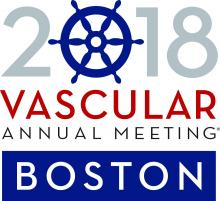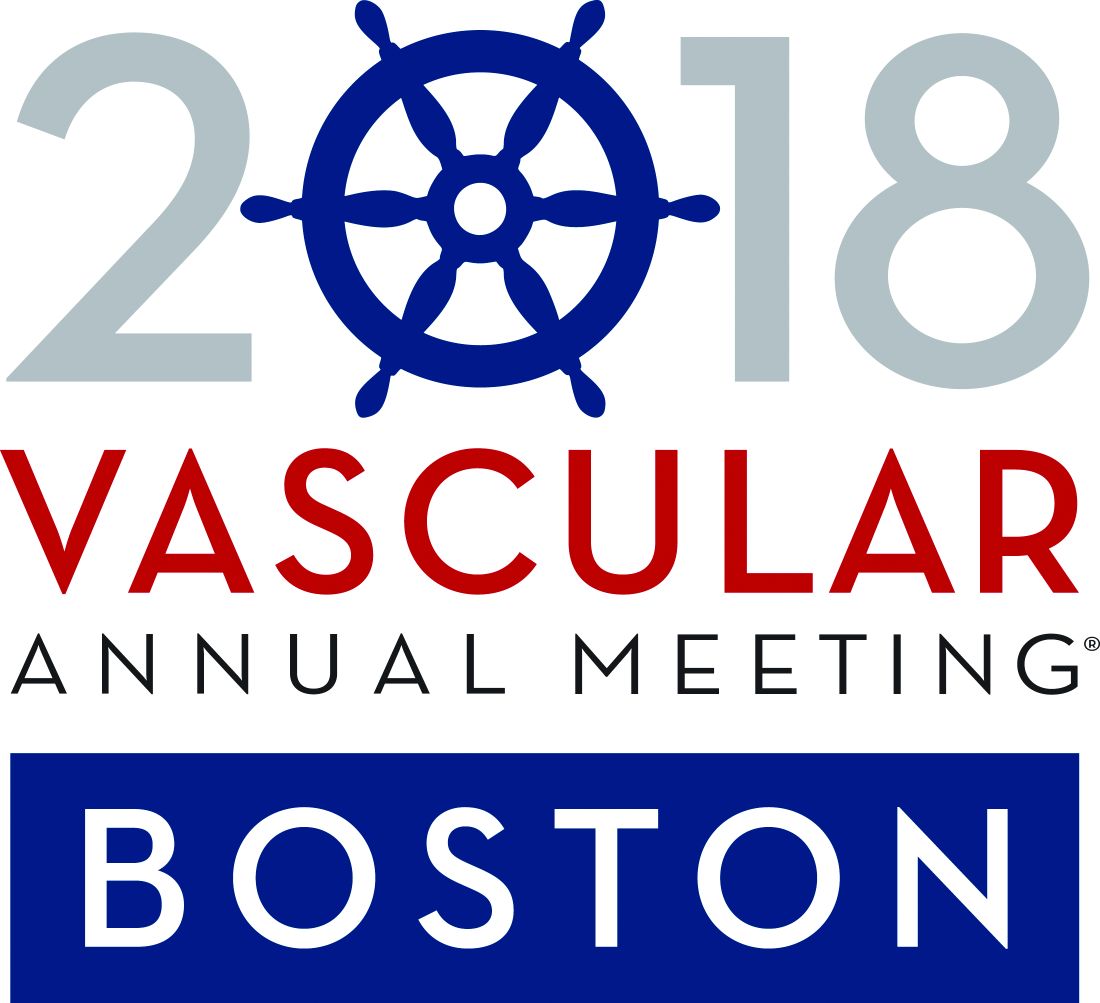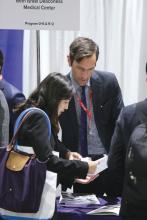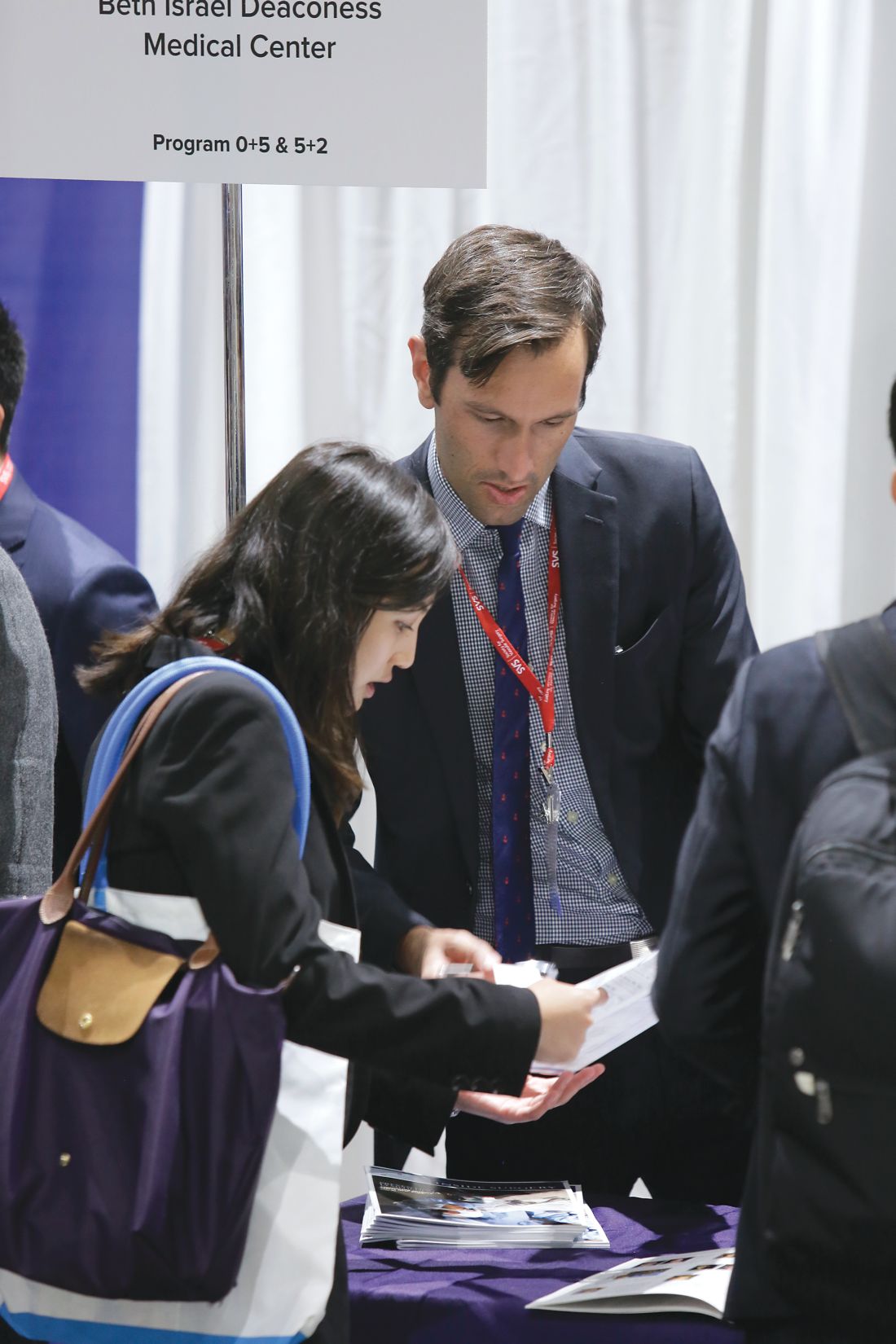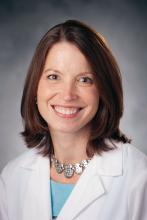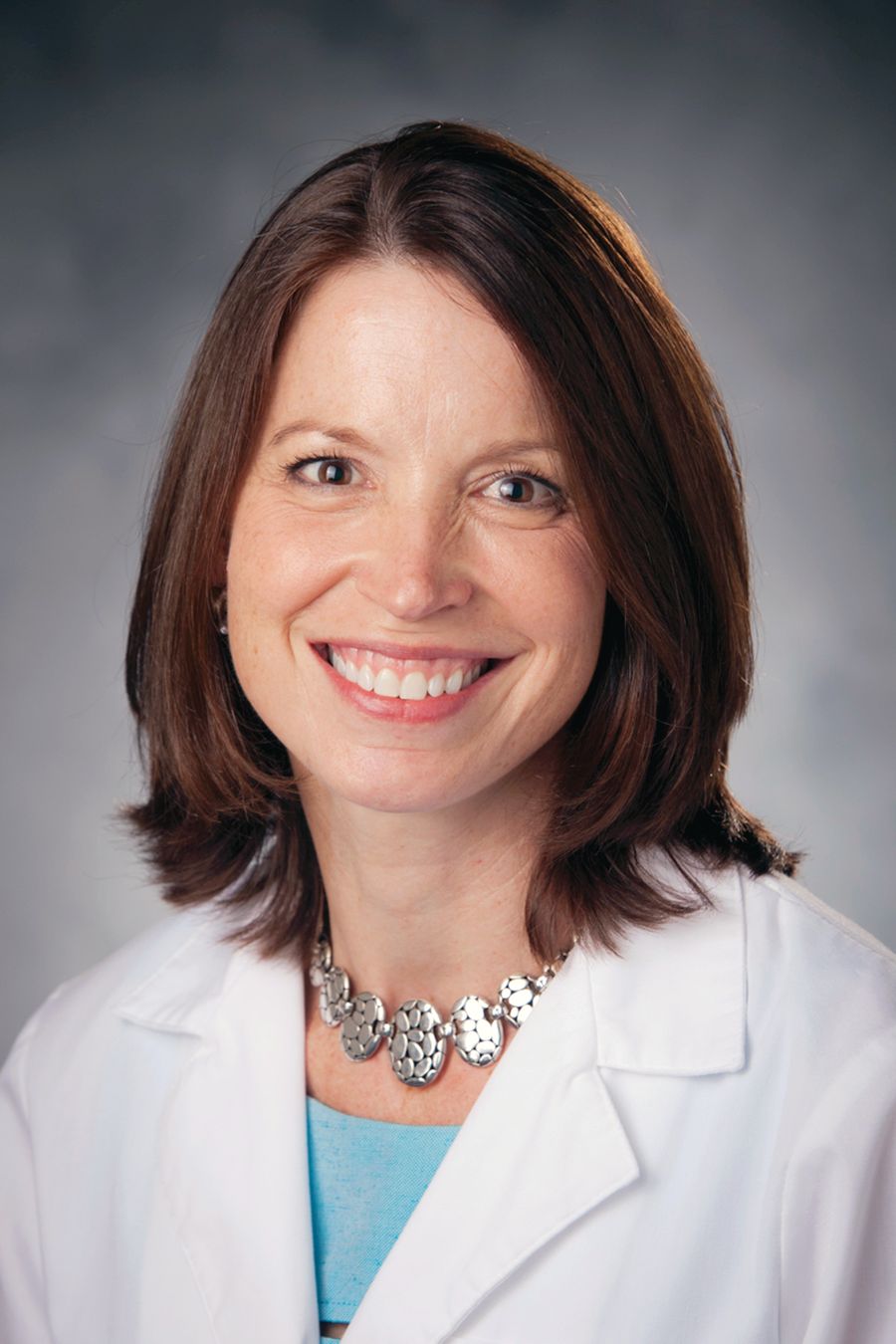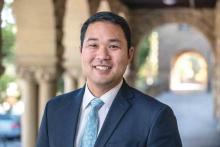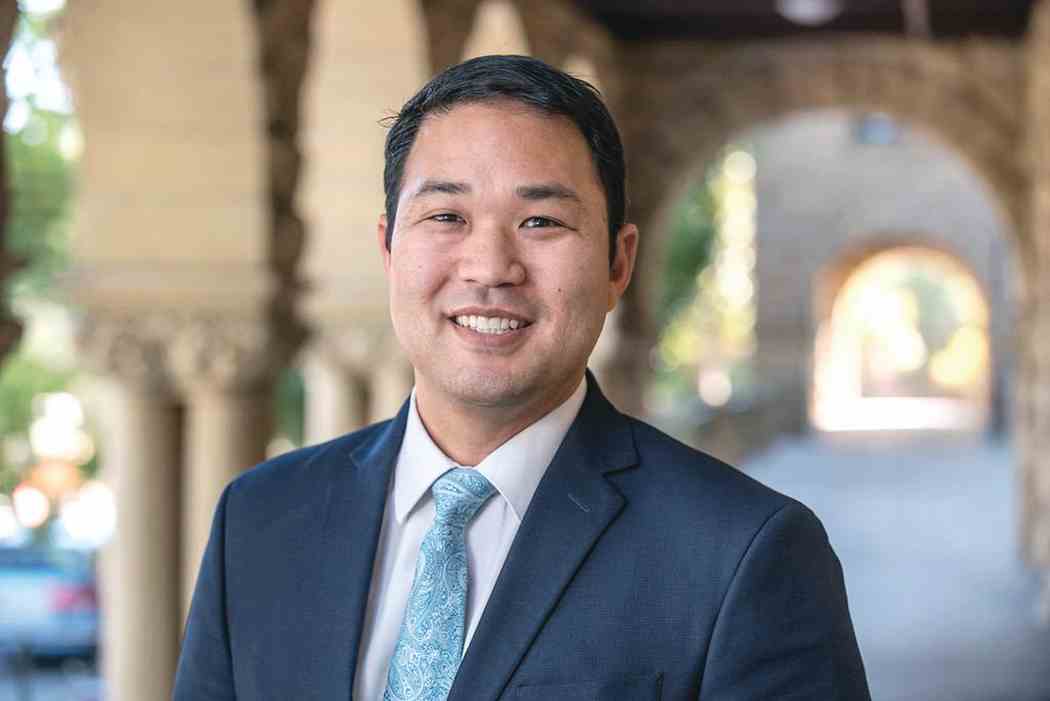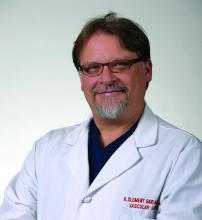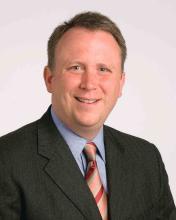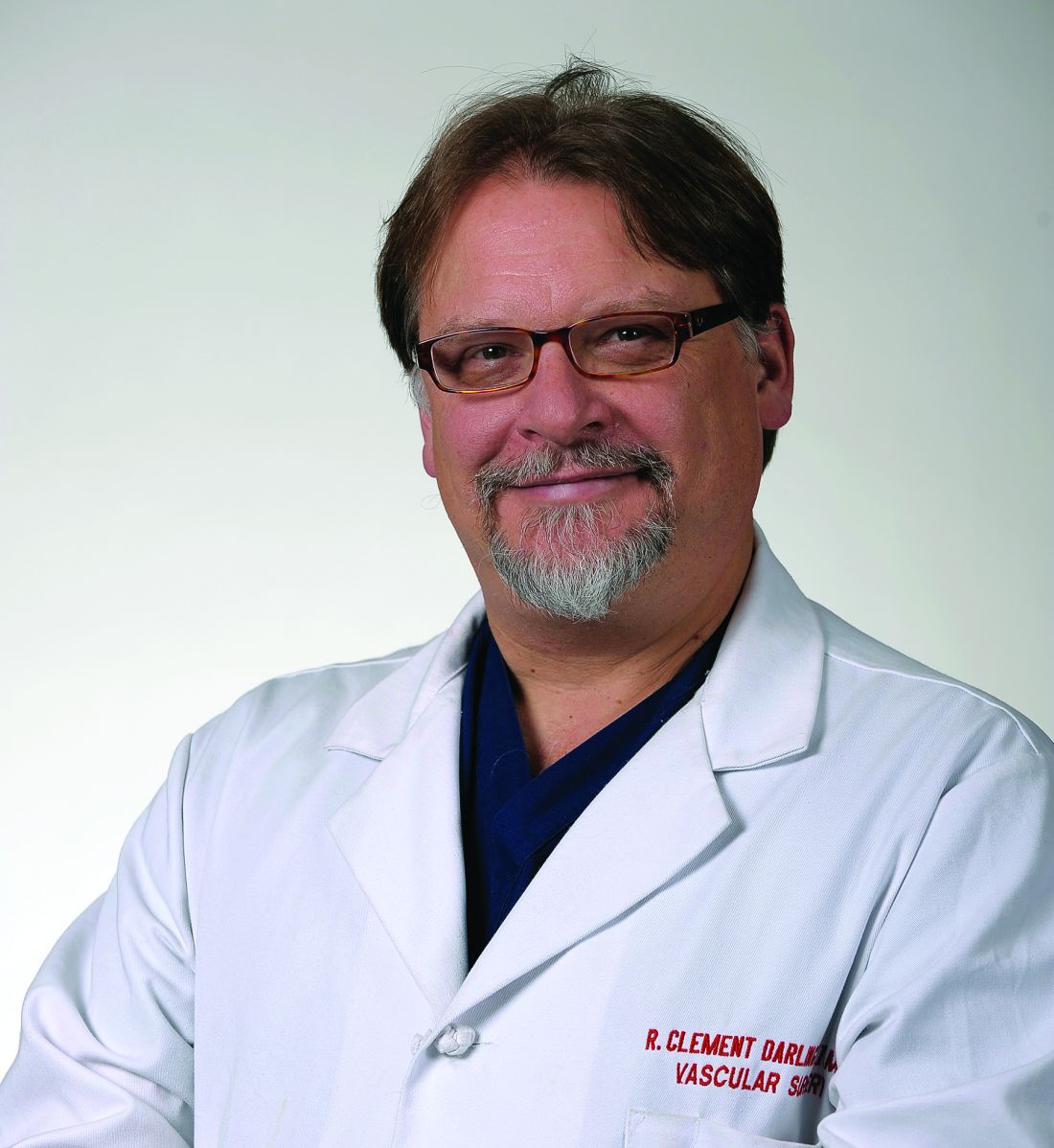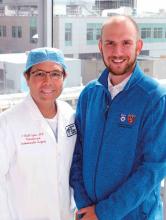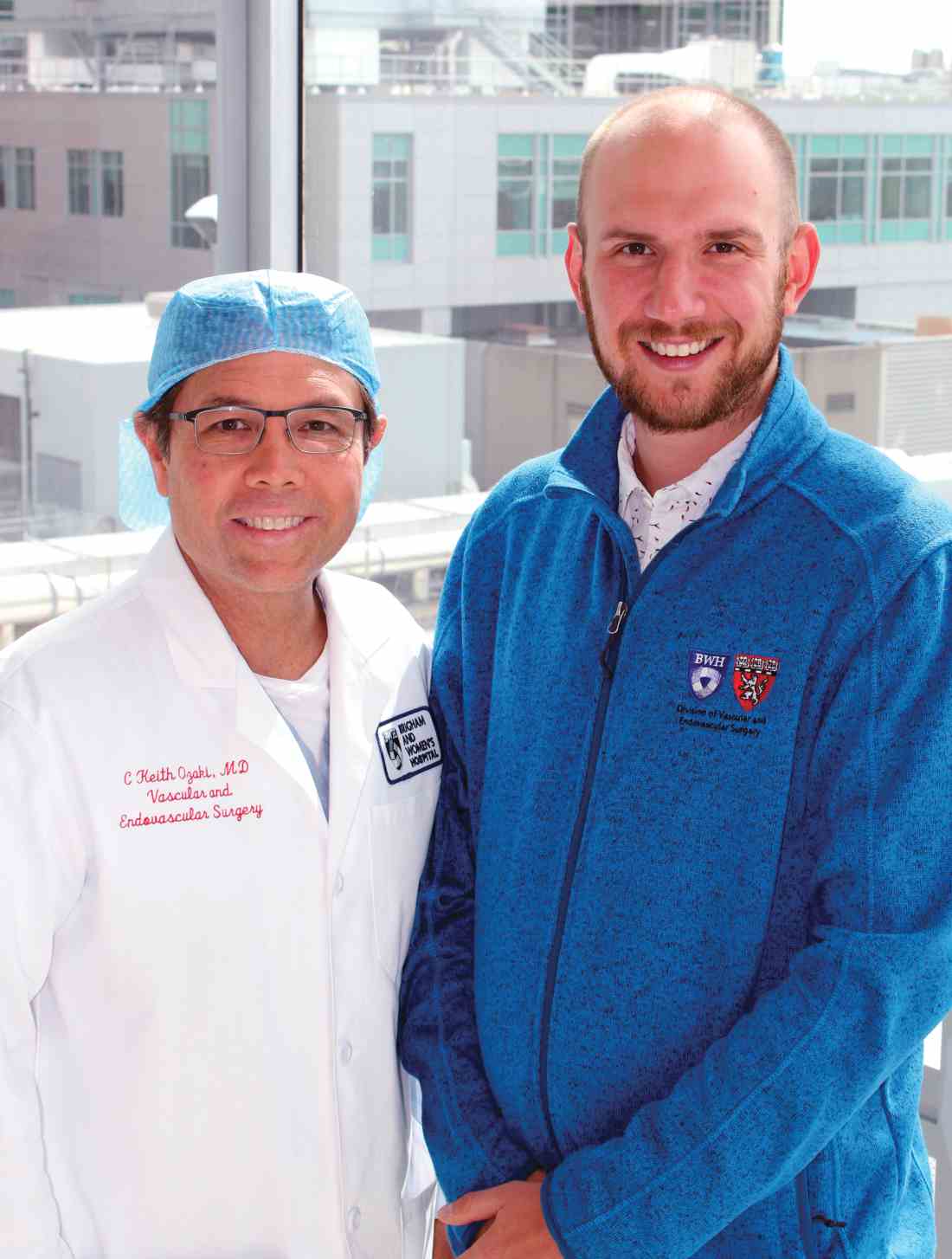User login
Mix and Mingle at Friday’s Closing Reception
Mark the closing of the Exhibit Hall by attending the Closing Reception, set for 4:30 to 5:30 p.m. Friday in the Auditorium on Level 2 of the Hynes Convention Center.
VAM attendees have one more chance to visit with vendors and check out innovations in devices and medications. Guests have another to meet with friends old and new, to relax, and to enjoy cocktails and hors d’oeuvres.
Tickets are required and are available at Registration.
Mark the closing of the Exhibit Hall by attending the Closing Reception, set for 4:30 to 5:30 p.m. Friday in the Auditorium on Level 2 of the Hynes Convention Center.
VAM attendees have one more chance to visit with vendors and check out innovations in devices and medications. Guests have another to meet with friends old and new, to relax, and to enjoy cocktails and hors d’oeuvres.
Tickets are required and are available at Registration.
Mark the closing of the Exhibit Hall by attending the Closing Reception, set for 4:30 to 5:30 p.m. Friday in the Auditorium on Level 2 of the Hynes Convention Center.
VAM attendees have one more chance to visit with vendors and check out innovations in devices and medications. Guests have another to meet with friends old and new, to relax, and to enjoy cocktails and hors d’oeuvres.
Tickets are required and are available at Registration.
Learn About Vascular Training Programs at Residency Fair
For those considering a career as a vascular surgeon, deciding on a training program is an important decision. Should it be a vascular fellowship (5+2) program, or one offering an integrated vascular residency (0+5)? Does following in the footsteps of Michael DeBakey, E. Stanley Crawford, and others at Baylor College of Medicine sound attractive? Or perhaps schools in the Southeast beckon.
Come to the Residency Fair, from 5 to 6:30 p.m. Friday to help narrow down the choices. There won’t be carnival rides or elephant ears, but there WILL be information available. Representatives from 67 programs (as of May 22, 2018) will be available in Exhibit Hall B to discuss their programs in detail and answer questions. Programs are arranged by the types of training paradigms: 0+5, 5+2, plus those offering both training pathways. Students seeking the right educational fit can more easily look at programs to locate those in which they are specifically interested – or even consider a choice that they might have earlier dismissed but now seems promising.
Residents and students also get the chance to network with program directors, faculty, and current trainees. A directory of all participating programs was distributed to students and residents earlier. The directory also will be available at the fair.
Advance registration is not required for the residency fair.
For those considering a career as a vascular surgeon, deciding on a training program is an important decision. Should it be a vascular fellowship (5+2) program, or one offering an integrated vascular residency (0+5)? Does following in the footsteps of Michael DeBakey, E. Stanley Crawford, and others at Baylor College of Medicine sound attractive? Or perhaps schools in the Southeast beckon.
Come to the Residency Fair, from 5 to 6:30 p.m. Friday to help narrow down the choices. There won’t be carnival rides or elephant ears, but there WILL be information available. Representatives from 67 programs (as of May 22, 2018) will be available in Exhibit Hall B to discuss their programs in detail and answer questions. Programs are arranged by the types of training paradigms: 0+5, 5+2, plus those offering both training pathways. Students seeking the right educational fit can more easily look at programs to locate those in which they are specifically interested – or even consider a choice that they might have earlier dismissed but now seems promising.
Residents and students also get the chance to network with program directors, faculty, and current trainees. A directory of all participating programs was distributed to students and residents earlier. The directory also will be available at the fair.
Advance registration is not required for the residency fair.
For those considering a career as a vascular surgeon, deciding on a training program is an important decision. Should it be a vascular fellowship (5+2) program, or one offering an integrated vascular residency (0+5)? Does following in the footsteps of Michael DeBakey, E. Stanley Crawford, and others at Baylor College of Medicine sound attractive? Or perhaps schools in the Southeast beckon.
Come to the Residency Fair, from 5 to 6:30 p.m. Friday to help narrow down the choices. There won’t be carnival rides or elephant ears, but there WILL be information available. Representatives from 67 programs (as of May 22, 2018) will be available in Exhibit Hall B to discuss their programs in detail and answer questions. Programs are arranged by the types of training paradigms: 0+5, 5+2, plus those offering both training pathways. Students seeking the right educational fit can more easily look at programs to locate those in which they are specifically interested – or even consider a choice that they might have earlier dismissed but now seems promising.
Residents and students also get the chance to network with program directors, faculty, and current trainees. A directory of all participating programs was distributed to students and residents earlier. The directory also will be available at the fair.
Advance registration is not required for the residency fair.
Advanced Practice Providers Vital to Vascular Team
The team approach has changed the entire field of medicine in the past 10-20 years and, in fact, is critical to optimal patient outcomes. That’s according to Anil Hingorani, MD, who will co-moderate a special forum Friday, “Improving Clinical Metrics With the Utilization of Advanced Practice Providers.”
It will be held from 1:30 to 3 p.m. in Ballroom A/B.
The team approach is front and center at this year’s Vascular Annual Meeting, which carries the theme: “Home of the Vascular Team – Partners in Patient Care.”
“Our vascular disease patients can be quite complex,” said Dr. Hingorani. “We will highlight that to take care of these complexities we need a team approach, and our team members can help tremendously.” This is true across the setting spectrum, be it rural, urban, suburban.
“Some NPs and PAs run our service. They help coordinate pre-op evaluations, post-op management, take care of research protocols, billing, and other office responsibilities,” he said.
He pointed out he is not a specialist in diabetes, but that his NP has a special interest and passion for the topic. The work she does for their diabetic patients “helps MY patients and helps MY procedures have better outcomes.”
PAs and NPs also help run research projects and are instrumental in working with fellows rotating through. With their work in what Dr. Hingorani referred to as the “three pillars” – clinical work, teaching, and research – they are tremendously important to the vascular team.
Advanced care providers also help improve outcomes, he said, when pay for performance and quantitating outcomes is becoming a standard part of health care. Admissions, discharges, surgical site infections, diabetes, follow-up all are important for patient care, and tracking all the details is vital to outcomes. It will be addressed in the forum, Dr. Hingorani said.
“Medicine is a specialty that hasn’t really caught on to MACRA, MIPS, and what pay for performance really entails,” he said. “Many are still figuring out, ‘What changes do I need to make to make this work for my patients and me? Where does my practice fit in?’ We’re going to have to keep working on that.”
Speakers will be primarily nurse practitioners and physician assistants. “We didn’t want surgeons telling PAs and NPs what they should be doing. It needs to be the PAs and NPs doing the speaking, focusing on issues important to them.”
Dr. Hingorani believes that the Vascular Annual Meeting is the first to stress the team approach theme. “I think it’s an important step and others will follow suit,” he said. “These ideas are resonating. They’re important and will be the way forward.
“I think we’ll be breaking new ground and will ripple across the societies.”
Besides a panel discussion at the end, forum topics include:
- Improving Metrics in Clinical Practice: The Value of APPs to a Vascular Practice
- There’s an APP for That: Workforce and Community Practice Experience
- National and International Trends in the Use of APPs, PAs in Surgery and Outcome Data
- Improving Metrics via Team-Based Care: The Wake Forest Baptist Health Experience
- Influence of APPs - MIPS and “Throughput” of Patients, Value/Quality/Financial Benefit and APPs
- Funny You Should Ask: What Advanced Practice Providers Bring to the Table
- How Advanced Practice Clinicians Can Add Value to Your Practice
- Driving Outcomes: University of Maryland Advanced Practice Providers Target Preventable Complications, Length of Stay, and Readmissions Univers LT Std
The team approach has changed the entire field of medicine in the past 10-20 years and, in fact, is critical to optimal patient outcomes. That’s according to Anil Hingorani, MD, who will co-moderate a special forum Friday, “Improving Clinical Metrics With the Utilization of Advanced Practice Providers.”
It will be held from 1:30 to 3 p.m. in Ballroom A/B.
The team approach is front and center at this year’s Vascular Annual Meeting, which carries the theme: “Home of the Vascular Team – Partners in Patient Care.”
“Our vascular disease patients can be quite complex,” said Dr. Hingorani. “We will highlight that to take care of these complexities we need a team approach, and our team members can help tremendously.” This is true across the setting spectrum, be it rural, urban, suburban.
“Some NPs and PAs run our service. They help coordinate pre-op evaluations, post-op management, take care of research protocols, billing, and other office responsibilities,” he said.
He pointed out he is not a specialist in diabetes, but that his NP has a special interest and passion for the topic. The work she does for their diabetic patients “helps MY patients and helps MY procedures have better outcomes.”
PAs and NPs also help run research projects and are instrumental in working with fellows rotating through. With their work in what Dr. Hingorani referred to as the “three pillars” – clinical work, teaching, and research – they are tremendously important to the vascular team.
Advanced care providers also help improve outcomes, he said, when pay for performance and quantitating outcomes is becoming a standard part of health care. Admissions, discharges, surgical site infections, diabetes, follow-up all are important for patient care, and tracking all the details is vital to outcomes. It will be addressed in the forum, Dr. Hingorani said.
“Medicine is a specialty that hasn’t really caught on to MACRA, MIPS, and what pay for performance really entails,” he said. “Many are still figuring out, ‘What changes do I need to make to make this work for my patients and me? Where does my practice fit in?’ We’re going to have to keep working on that.”
Speakers will be primarily nurse practitioners and physician assistants. “We didn’t want surgeons telling PAs and NPs what they should be doing. It needs to be the PAs and NPs doing the speaking, focusing on issues important to them.”
Dr. Hingorani believes that the Vascular Annual Meeting is the first to stress the team approach theme. “I think it’s an important step and others will follow suit,” he said. “These ideas are resonating. They’re important and will be the way forward.
“I think we’ll be breaking new ground and will ripple across the societies.”
Besides a panel discussion at the end, forum topics include:
- Improving Metrics in Clinical Practice: The Value of APPs to a Vascular Practice
- There’s an APP for That: Workforce and Community Practice Experience
- National and International Trends in the Use of APPs, PAs in Surgery and Outcome Data
- Improving Metrics via Team-Based Care: The Wake Forest Baptist Health Experience
- Influence of APPs - MIPS and “Throughput” of Patients, Value/Quality/Financial Benefit and APPs
- Funny You Should Ask: What Advanced Practice Providers Bring to the Table
- How Advanced Practice Clinicians Can Add Value to Your Practice
- Driving Outcomes: University of Maryland Advanced Practice Providers Target Preventable Complications, Length of Stay, and Readmissions Univers LT Std
The team approach has changed the entire field of medicine in the past 10-20 years and, in fact, is critical to optimal patient outcomes. That’s according to Anil Hingorani, MD, who will co-moderate a special forum Friday, “Improving Clinical Metrics With the Utilization of Advanced Practice Providers.”
It will be held from 1:30 to 3 p.m. in Ballroom A/B.
The team approach is front and center at this year’s Vascular Annual Meeting, which carries the theme: “Home of the Vascular Team – Partners in Patient Care.”
“Our vascular disease patients can be quite complex,” said Dr. Hingorani. “We will highlight that to take care of these complexities we need a team approach, and our team members can help tremendously.” This is true across the setting spectrum, be it rural, urban, suburban.
“Some NPs and PAs run our service. They help coordinate pre-op evaluations, post-op management, take care of research protocols, billing, and other office responsibilities,” he said.
He pointed out he is not a specialist in diabetes, but that his NP has a special interest and passion for the topic. The work she does for their diabetic patients “helps MY patients and helps MY procedures have better outcomes.”
PAs and NPs also help run research projects and are instrumental in working with fellows rotating through. With their work in what Dr. Hingorani referred to as the “three pillars” – clinical work, teaching, and research – they are tremendously important to the vascular team.
Advanced care providers also help improve outcomes, he said, when pay for performance and quantitating outcomes is becoming a standard part of health care. Admissions, discharges, surgical site infections, diabetes, follow-up all are important for patient care, and tracking all the details is vital to outcomes. It will be addressed in the forum, Dr. Hingorani said.
“Medicine is a specialty that hasn’t really caught on to MACRA, MIPS, and what pay for performance really entails,” he said. “Many are still figuring out, ‘What changes do I need to make to make this work for my patients and me? Where does my practice fit in?’ We’re going to have to keep working on that.”
Speakers will be primarily nurse practitioners and physician assistants. “We didn’t want surgeons telling PAs and NPs what they should be doing. It needs to be the PAs and NPs doing the speaking, focusing on issues important to them.”
Dr. Hingorani believes that the Vascular Annual Meeting is the first to stress the team approach theme. “I think it’s an important step and others will follow suit,” he said. “These ideas are resonating. They’re important and will be the way forward.
“I think we’ll be breaking new ground and will ripple across the societies.”
Besides a panel discussion at the end, forum topics include:
- Improving Metrics in Clinical Practice: The Value of APPs to a Vascular Practice
- There’s an APP for That: Workforce and Community Practice Experience
- National and International Trends in the Use of APPs, PAs in Surgery and Outcome Data
- Improving Metrics via Team-Based Care: The Wake Forest Baptist Health Experience
- Influence of APPs - MIPS and “Throughput” of Patients, Value/Quality/Financial Benefit and APPs
- Funny You Should Ask: What Advanced Practice Providers Bring to the Table
- How Advanced Practice Clinicians Can Add Value to Your Practice
- Driving Outcomes: University of Maryland Advanced Practice Providers Target Preventable Complications, Length of Stay, and Readmissions Univers LT Std
Session for Young Surgeons
Young vascular surgeons can get guidance on successfully transitioning from training to practice in C5: Management Tips and Tricks for Young Vascular Surgeons. It will be held from 1:30 to 3 p.m. in HCC, Room 311. The interactive program will focus on topics not necessarily covered in residency and is recommended by both the Community Practice and Young Surgeons committees. More info here.
Young vascular surgeons can get guidance on successfully transitioning from training to practice in C5: Management Tips and Tricks for Young Vascular Surgeons. It will be held from 1:30 to 3 p.m. in HCC, Room 311. The interactive program will focus on topics not necessarily covered in residency and is recommended by both the Community Practice and Young Surgeons committees. More info here.
Young vascular surgeons can get guidance on successfully transitioning from training to practice in C5: Management Tips and Tricks for Young Vascular Surgeons. It will be held from 1:30 to 3 p.m. in HCC, Room 311. The interactive program will focus on topics not necessarily covered in residency and is recommended by both the Community Practice and Young Surgeons committees. More info here.
Treat Acute PE With a Team Approach
Current advancements and care of acute pulmonary embolism (PE) patients will be the focus of Wednesday morning’s session, “Treating Acute PE and Developing a Pulmonary Embolism Response Team.”
“PE is a silent killer and its incidence is only increasing,” said session co-moderator Linda Le, MD, an assistant professor of cardiovascular surgery at Houston Methodist Hospital in Texas. “In recent years, there has been more evidence to support a streamlined approach with a collaborative PE response team to not only improve patient outcomes but also to decrease the incidence and long-term morbidity of this disease.”Populations at highest risk for PE include those who have had surgery or trauma, or women around the time of childbirth, said session co-moderator Ellen Dillavou, MD, an associate professor of surgery at Duke University Medical Center in Durham, N.C. “We have a variety of new devices that can treat patients safely and effectively with lower lytic doses and smaller profiles. We are also gaining knowledge regarding the incidence of post-PE pulmonary hypertension. We are figuring out who is at risk and what treatments are needed.”
The session will cover the morbidity of severe PE, practical noninvasive diagnostic imaging techniques, risk stratification, and appropriate treatment options. Two talks will address how to develop a PE response team (PERT) collaboration and go over the role of the PERT in massive and submassive PE. These teams – a cooperation of multiple specialties that can include cardiologists, intensivists, vascular surgeons, cardiac surgeons, ER physicians, pulmonologists, and interventional radiologists – are becoming more common in large academic centers and some community hospitals. “The goals of a PERT team are to respond rapidly when a diagnosis of massive or submassive PE is made, as well as to individualize and coordinate care for these complex patients,” Dr. Le said. “A fundamental component of the team is the collaboration of multiple specialties in which all experts involved have the same goals in mind – to improve patient outcomes.”
PERT teams are effective and a good way to establish intra-institutional collaboration, Dr. Dillavou said. When creating a PERT, she said, “It is really important to see what people are qualified and enthusiastic in your area. All politics are local, so partnering with other specialists is key. I like to start these projects by coming in with an outline and plans, but then inviting others to contribute so everyone feels they have a voice and so the best practices can be derived.”
“These presentations will give current PERT users up-to-the-minute information that attendees can take back to their home institutions to make sure best practices are being used,” said Dr. Dillavou. “For those starting out, there will be a lot of practical advice. The lecturers also will be available for questions and tips.”
Wednesday
10:15 a.m.-1:15 p.m.
HCC, Room 304
P4: Treating Acute PE and Developing a Pulmonary Embolism Response Team (PERT)
Current advancements and care of acute pulmonary embolism (PE) patients will be the focus of Wednesday morning’s session, “Treating Acute PE and Developing a Pulmonary Embolism Response Team.”
“PE is a silent killer and its incidence is only increasing,” said session co-moderator Linda Le, MD, an assistant professor of cardiovascular surgery at Houston Methodist Hospital in Texas. “In recent years, there has been more evidence to support a streamlined approach with a collaborative PE response team to not only improve patient outcomes but also to decrease the incidence and long-term morbidity of this disease.”Populations at highest risk for PE include those who have had surgery or trauma, or women around the time of childbirth, said session co-moderator Ellen Dillavou, MD, an associate professor of surgery at Duke University Medical Center in Durham, N.C. “We have a variety of new devices that can treat patients safely and effectively with lower lytic doses and smaller profiles. We are also gaining knowledge regarding the incidence of post-PE pulmonary hypertension. We are figuring out who is at risk and what treatments are needed.”
The session will cover the morbidity of severe PE, practical noninvasive diagnostic imaging techniques, risk stratification, and appropriate treatment options. Two talks will address how to develop a PE response team (PERT) collaboration and go over the role of the PERT in massive and submassive PE. These teams – a cooperation of multiple specialties that can include cardiologists, intensivists, vascular surgeons, cardiac surgeons, ER physicians, pulmonologists, and interventional radiologists – are becoming more common in large academic centers and some community hospitals. “The goals of a PERT team are to respond rapidly when a diagnosis of massive or submassive PE is made, as well as to individualize and coordinate care for these complex patients,” Dr. Le said. “A fundamental component of the team is the collaboration of multiple specialties in which all experts involved have the same goals in mind – to improve patient outcomes.”
PERT teams are effective and a good way to establish intra-institutional collaboration, Dr. Dillavou said. When creating a PERT, she said, “It is really important to see what people are qualified and enthusiastic in your area. All politics are local, so partnering with other specialists is key. I like to start these projects by coming in with an outline and plans, but then inviting others to contribute so everyone feels they have a voice and so the best practices can be derived.”
“These presentations will give current PERT users up-to-the-minute information that attendees can take back to their home institutions to make sure best practices are being used,” said Dr. Dillavou. “For those starting out, there will be a lot of practical advice. The lecturers also will be available for questions and tips.”
Wednesday
10:15 a.m.-1:15 p.m.
HCC, Room 304
P4: Treating Acute PE and Developing a Pulmonary Embolism Response Team (PERT)
Current advancements and care of acute pulmonary embolism (PE) patients will be the focus of Wednesday morning’s session, “Treating Acute PE and Developing a Pulmonary Embolism Response Team.”
“PE is a silent killer and its incidence is only increasing,” said session co-moderator Linda Le, MD, an assistant professor of cardiovascular surgery at Houston Methodist Hospital in Texas. “In recent years, there has been more evidence to support a streamlined approach with a collaborative PE response team to not only improve patient outcomes but also to decrease the incidence and long-term morbidity of this disease.”Populations at highest risk for PE include those who have had surgery or trauma, or women around the time of childbirth, said session co-moderator Ellen Dillavou, MD, an associate professor of surgery at Duke University Medical Center in Durham, N.C. “We have a variety of new devices that can treat patients safely and effectively with lower lytic doses and smaller profiles. We are also gaining knowledge regarding the incidence of post-PE pulmonary hypertension. We are figuring out who is at risk and what treatments are needed.”
The session will cover the morbidity of severe PE, practical noninvasive diagnostic imaging techniques, risk stratification, and appropriate treatment options. Two talks will address how to develop a PE response team (PERT) collaboration and go over the role of the PERT in massive and submassive PE. These teams – a cooperation of multiple specialties that can include cardiologists, intensivists, vascular surgeons, cardiac surgeons, ER physicians, pulmonologists, and interventional radiologists – are becoming more common in large academic centers and some community hospitals. “The goals of a PERT team are to respond rapidly when a diagnosis of massive or submassive PE is made, as well as to individualize and coordinate care for these complex patients,” Dr. Le said. “A fundamental component of the team is the collaboration of multiple specialties in which all experts involved have the same goals in mind – to improve patient outcomes.”
PERT teams are effective and a good way to establish intra-institutional collaboration, Dr. Dillavou said. When creating a PERT, she said, “It is really important to see what people are qualified and enthusiastic in your area. All politics are local, so partnering with other specialists is key. I like to start these projects by coming in with an outline and plans, but then inviting others to contribute so everyone feels they have a voice and so the best practices can be derived.”
“These presentations will give current PERT users up-to-the-minute information that attendees can take back to their home institutions to make sure best practices are being used,” said Dr. Dillavou. “For those starting out, there will be a lot of practical advice. The lecturers also will be available for questions and tips.”
Wednesday
10:15 a.m.-1:15 p.m.
HCC, Room 304
P4: Treating Acute PE and Developing a Pulmonary Embolism Response Team (PERT)
SVS Booth will be in the Exhibit Hall
SVS members who are attending the Vascular Annual Meeting can get in-person help with any application issues, or, indeed any membership services concerns. The SVS Booth, #1015, in the Exhibit Hall will be staffed both Thursday and Friday, June 21-22. SVS staff members will be able to provide information on a wide range of topics, including:
• Member services, including
- The benefits of belonging
- Dues
- Membership applications
- Log-in issues
- Contact information updates – don’t fall off the contacts list!
• The Affinity Program of expanded benefits
• Educational products, including the fourth edition of the Vascular Education Self-Assessment Program (VESAP), the SVS coding Class, the SVS Vascular Research Initiatives Conference and the Rutherford’s Vascular Surgery book.
• The Journal of Vascular Surgery publications (offering JVS socks!)
• The SVS Patient Safety Organization Vascular Quality Initiative
• Quality and clinical practice guideline initiatives (including printed copies of four of the latest SVS guidelines)
• The Mobile App or VAM Planner
• The SVS Foundation and the SVS Political Action Committee; members can make a donation to either or both
• Scan the QR code as part of the Exhibit Hall Scavenger Hunt
Enter to win a prize: Those who drop by can be entered into a drawing for three prizes: an SVS Membership waiver for next year, free VAM 2019 registration and VAM on Demand from the ’18 meeting. In addition, while supplies last, visitors also can pick up a memento of their visit.
SVS members who are attending the Vascular Annual Meeting can get in-person help with any application issues, or, indeed any membership services concerns. The SVS Booth, #1015, in the Exhibit Hall will be staffed both Thursday and Friday, June 21-22. SVS staff members will be able to provide information on a wide range of topics, including:
• Member services, including
- The benefits of belonging
- Dues
- Membership applications
- Log-in issues
- Contact information updates – don’t fall off the contacts list!
• The Affinity Program of expanded benefits
• Educational products, including the fourth edition of the Vascular Education Self-Assessment Program (VESAP), the SVS coding Class, the SVS Vascular Research Initiatives Conference and the Rutherford’s Vascular Surgery book.
• The Journal of Vascular Surgery publications (offering JVS socks!)
• The SVS Patient Safety Organization Vascular Quality Initiative
• Quality and clinical practice guideline initiatives (including printed copies of four of the latest SVS guidelines)
• The Mobile App or VAM Planner
• The SVS Foundation and the SVS Political Action Committee; members can make a donation to either or both
• Scan the QR code as part of the Exhibit Hall Scavenger Hunt
Enter to win a prize: Those who drop by can be entered into a drawing for three prizes: an SVS Membership waiver for next year, free VAM 2019 registration and VAM on Demand from the ’18 meeting. In addition, while supplies last, visitors also can pick up a memento of their visit.
SVS members who are attending the Vascular Annual Meeting can get in-person help with any application issues, or, indeed any membership services concerns. The SVS Booth, #1015, in the Exhibit Hall will be staffed both Thursday and Friday, June 21-22. SVS staff members will be able to provide information on a wide range of topics, including:
• Member services, including
- The benefits of belonging
- Dues
- Membership applications
- Log-in issues
- Contact information updates – don’t fall off the contacts list!
• The Affinity Program of expanded benefits
• Educational products, including the fourth edition of the Vascular Education Self-Assessment Program (VESAP), the SVS coding Class, the SVS Vascular Research Initiatives Conference and the Rutherford’s Vascular Surgery book.
• The Journal of Vascular Surgery publications (offering JVS socks!)
• The SVS Patient Safety Organization Vascular Quality Initiative
• Quality and clinical practice guideline initiatives (including printed copies of four of the latest SVS guidelines)
• The Mobile App or VAM Planner
• The SVS Foundation and the SVS Political Action Committee; members can make a donation to either or both
• Scan the QR code as part of the Exhibit Hall Scavenger Hunt
Enter to win a prize: Those who drop by can be entered into a drawing for three prizes: an SVS Membership waiver for next year, free VAM 2019 registration and VAM on Demand from the ’18 meeting. In addition, while supplies last, visitors also can pick up a memento of their visit.
A Look into the Future at the Crawford Forum
Will the demand be sufficient for the supply of the vascular surgery work force in the United States? That topic, along with potential solutions, will be front and center at the E. Stanley Crawford Critical Issues Forum from 10:30 a.m. to 12 p.m. See HCC, Ballroom A/B.
Will the demand be sufficient for the supply of the vascular surgery work force in the United States? That topic, along with potential solutions, will be front and center at the E. Stanley Crawford Critical Issues Forum from 10:30 a.m. to 12 p.m. See HCC, Ballroom A/B.
Will the demand be sufficient for the supply of the vascular surgery work force in the United States? That topic, along with potential solutions, will be front and center at the E. Stanley Crawford Critical Issues Forum from 10:30 a.m. to 12 p.m. See HCC, Ballroom A/B.
PAD Patients at Risk for High Opioid Use
National efforts have intensified to reduce opioid prescriptions because of the opioid crisis. However, little is known about the relationship between peripheral arterial disease (PAD) and high-risk opioid use, according to Nathan K. Itoga, MD, of Stanford University, Calif. “As a vascular surgery resident, I wanted to know how I could do my part in reducing opioid prescriptions. However, I didn’t know if vascular patients were at risk for high opioid use. The impetus for this study was the lack of studies regarding opioid use in patients with vascular disease,” said Dr. Itoga.
Dr. Itoga will present a study in Thursday’s Scientific Session 2 that he and his colleagues performed to evaluate the relationship between PAD and high opioid use and to assess whether PAD treatment impacts high opioid use.
The researchers used the 2007-2015 Truven Marketscan database, a deidentified national private insurance claims database, to identify patients with 2 ICD-9 diagnosis codes of PAD 2 months apart with at least 2 years of continuous enrollment. Critical limb ischemia (CLI) was defined as rest pain, ulcers, or gangrene.
“Our primary outcome was high opioid use, defined as 2 opioid prescriptions within a 1-year period,” said Dr. Itoga. Opioid prescriptions were excluded if filled within 90 days of a PAD-related procedure, as identified by CPT codes for lower extremity open/endovascular revascularization or amputation. A total of 182,186 patients with PAD met the inclusion criteria, 27.1% of whom had CLI. The mean follow-up was 5.29 years. An average of 24.4% of patients with PAD met the high opioid use criteria in any given calendar year, with a significant decreasing trend for patients meeting criteria beginning in 2010 (P less than .01), said Dr. Itoga. Among the high opioid users, 26.0% continued to meet the criteria for 5 years. High opioid use was found to be significantly more common for patients with CLI (32.2%) compared to PAD patients without CLI (vs. 21.4%). During years of high opioid use, an average of 5.9 yearly prescriptions was filled.
According to multivariate analysis, illicit drug use and back pain were the strongest significant predictors of high opioid use (P less than .001).
A new diagnosis of PAD significantly increased the incidence of high opioid use (21.3% before PAD diagnosis vs. 26.9% after diagnosis, P less than .01). This association with a new diagnosis of CLI increased high opioid use from 27.5% before CLI diagnosis to 37.7% after CLI diagnosis (P less than .01), highlighting the increased risk in this patient population. A total of 45,028 patients (24.7%) underwent 88,229 PAD-related procedures. After exclusion of periprocedural opioid prescriptions (18% of all opioid prescriptions), the yearly percentage of high opioid users increased from 25.6% pretreatment to 29.2% post treatment, also a significant difference (P less than .01).
“Our research shows that patients with PAD are at increased risk for high opioid use, with nearly one-quarter meeting described criteria. CLI additionally increases opioid utilization, and treatment of PAD does not appear to decrease high opioid use,” he said. “In addition to heightened awareness and active opioid management, our findings warrant further investigation into causes and deterrence of high-risk opioid use,” Dr. Itoga concluded.
Thursday, June 21, 2018
1:30 - 3:00 p.m.
HCC, Ballroom A/B
S2: Scientific Session 2
National efforts have intensified to reduce opioid prescriptions because of the opioid crisis. However, little is known about the relationship between peripheral arterial disease (PAD) and high-risk opioid use, according to Nathan K. Itoga, MD, of Stanford University, Calif. “As a vascular surgery resident, I wanted to know how I could do my part in reducing opioid prescriptions. However, I didn’t know if vascular patients were at risk for high opioid use. The impetus for this study was the lack of studies regarding opioid use in patients with vascular disease,” said Dr. Itoga.
Dr. Itoga will present a study in Thursday’s Scientific Session 2 that he and his colleagues performed to evaluate the relationship between PAD and high opioid use and to assess whether PAD treatment impacts high opioid use.
The researchers used the 2007-2015 Truven Marketscan database, a deidentified national private insurance claims database, to identify patients with 2 ICD-9 diagnosis codes of PAD 2 months apart with at least 2 years of continuous enrollment. Critical limb ischemia (CLI) was defined as rest pain, ulcers, or gangrene.
“Our primary outcome was high opioid use, defined as 2 opioid prescriptions within a 1-year period,” said Dr. Itoga. Opioid prescriptions were excluded if filled within 90 days of a PAD-related procedure, as identified by CPT codes for lower extremity open/endovascular revascularization or amputation. A total of 182,186 patients with PAD met the inclusion criteria, 27.1% of whom had CLI. The mean follow-up was 5.29 years. An average of 24.4% of patients with PAD met the high opioid use criteria in any given calendar year, with a significant decreasing trend for patients meeting criteria beginning in 2010 (P less than .01), said Dr. Itoga. Among the high opioid users, 26.0% continued to meet the criteria for 5 years. High opioid use was found to be significantly more common for patients with CLI (32.2%) compared to PAD patients without CLI (vs. 21.4%). During years of high opioid use, an average of 5.9 yearly prescriptions was filled.
According to multivariate analysis, illicit drug use and back pain were the strongest significant predictors of high opioid use (P less than .001).
A new diagnosis of PAD significantly increased the incidence of high opioid use (21.3% before PAD diagnosis vs. 26.9% after diagnosis, P less than .01). This association with a new diagnosis of CLI increased high opioid use from 27.5% before CLI diagnosis to 37.7% after CLI diagnosis (P less than .01), highlighting the increased risk in this patient population. A total of 45,028 patients (24.7%) underwent 88,229 PAD-related procedures. After exclusion of periprocedural opioid prescriptions (18% of all opioid prescriptions), the yearly percentage of high opioid users increased from 25.6% pretreatment to 29.2% post treatment, also a significant difference (P less than .01).
“Our research shows that patients with PAD are at increased risk for high opioid use, with nearly one-quarter meeting described criteria. CLI additionally increases opioid utilization, and treatment of PAD does not appear to decrease high opioid use,” he said. “In addition to heightened awareness and active opioid management, our findings warrant further investigation into causes and deterrence of high-risk opioid use,” Dr. Itoga concluded.
Thursday, June 21, 2018
1:30 - 3:00 p.m.
HCC, Ballroom A/B
S2: Scientific Session 2
National efforts have intensified to reduce opioid prescriptions because of the opioid crisis. However, little is known about the relationship between peripheral arterial disease (PAD) and high-risk opioid use, according to Nathan K. Itoga, MD, of Stanford University, Calif. “As a vascular surgery resident, I wanted to know how I could do my part in reducing opioid prescriptions. However, I didn’t know if vascular patients were at risk for high opioid use. The impetus for this study was the lack of studies regarding opioid use in patients with vascular disease,” said Dr. Itoga.
Dr. Itoga will present a study in Thursday’s Scientific Session 2 that he and his colleagues performed to evaluate the relationship between PAD and high opioid use and to assess whether PAD treatment impacts high opioid use.
The researchers used the 2007-2015 Truven Marketscan database, a deidentified national private insurance claims database, to identify patients with 2 ICD-9 diagnosis codes of PAD 2 months apart with at least 2 years of continuous enrollment. Critical limb ischemia (CLI) was defined as rest pain, ulcers, or gangrene.
“Our primary outcome was high opioid use, defined as 2 opioid prescriptions within a 1-year period,” said Dr. Itoga. Opioid prescriptions were excluded if filled within 90 days of a PAD-related procedure, as identified by CPT codes for lower extremity open/endovascular revascularization or amputation. A total of 182,186 patients with PAD met the inclusion criteria, 27.1% of whom had CLI. The mean follow-up was 5.29 years. An average of 24.4% of patients with PAD met the high opioid use criteria in any given calendar year, with a significant decreasing trend for patients meeting criteria beginning in 2010 (P less than .01), said Dr. Itoga. Among the high opioid users, 26.0% continued to meet the criteria for 5 years. High opioid use was found to be significantly more common for patients with CLI (32.2%) compared to PAD patients without CLI (vs. 21.4%). During years of high opioid use, an average of 5.9 yearly prescriptions was filled.
According to multivariate analysis, illicit drug use and back pain were the strongest significant predictors of high opioid use (P less than .001).
A new diagnosis of PAD significantly increased the incidence of high opioid use (21.3% before PAD diagnosis vs. 26.9% after diagnosis, P less than .01). This association with a new diagnosis of CLI increased high opioid use from 27.5% before CLI diagnosis to 37.7% after CLI diagnosis (P less than .01), highlighting the increased risk in this patient population. A total of 45,028 patients (24.7%) underwent 88,229 PAD-related procedures. After exclusion of periprocedural opioid prescriptions (18% of all opioid prescriptions), the yearly percentage of high opioid users increased from 25.6% pretreatment to 29.2% post treatment, also a significant difference (P less than .01).
“Our research shows that patients with PAD are at increased risk for high opioid use, with nearly one-quarter meeting described criteria. CLI additionally increases opioid utilization, and treatment of PAD does not appear to decrease high opioid use,” he said. “In addition to heightened awareness and active opioid management, our findings warrant further investigation into causes and deterrence of high-risk opioid use,” Dr. Itoga concluded.
Thursday, June 21, 2018
1:30 - 3:00 p.m.
HCC, Ballroom A/B
S2: Scientific Session 2
SVS von Liebig Forum: Complex Aortic Endografting
Innovative approaches to minimally invasive repair of the aorta will be featured during Thursday morning’s William J. von Liebig Forum.
“This year, the forum’s focus is on complex aortic endografting for a wide variety of aortic diseases, predominantly thoracoabdominal aortic aneurysms and aortic dissections,” said session co-moderator Matthew Eagleton, MD, chief of the division of vascular and endovascular surgery at Massachusetts General Hospital in Boston. “Surgeons who treat aortic disease will learn about new devices and new techniques that they will want to incorporate into their practice. They’ll also learn whether some of the techniques and procedures they are currently employing are still worth doing or may have unforeseen risks. Should they change their practices and approaches to patients with complex aortic disease, or should they continue down the road and recognize that it’s safe for patients?” The session will feature eight abstracts from vascular surgeons in the United States and Europe that will accentuate some of the newer, advanced technology, said session co-moderator R. Clement Darling III, MD, chief of the division of vascular surgery at Albany Medical Center Hospital in New York.
“To minimize the complications of complex aortic aneurysm repair, endovascular technology has to be evaluated, and we need to know what works, what doesn’t, and what are the long-term outcomes,” he said. “These presentations will help us understand the best techniques and the best current and future technology in percutaneous repair of complex aneurysms from the aortic arch down to the abdominal aorta.”
The program kicks off with a talk by Emanuel R. Tenorio, MD, PhD, of the Mayo Clinic about a prospective, nonrandomized study to evaluate cone beam computed tomography for technical assessment of standard and complex endovascular aortic repair. In other presentations, Tilo Kölbel, MD, PhD, of the University Heart Center Hamburg in Germany will discuss a single-center experience with a double-branched aortic arch endograft, technology not yet available in the United States. A U.S. national consortium, organized to better assess outcomes for endovascular therapy for complex aortic disease, will discuss their work with target artery outcomes after branched and fenestrated endovascular repair of pararenal and thoracoabdominal aortic aneurysms in the U.S. IDE (investigational device exemption) experience, and a group from Bologna, Italy, will discuss the risk of aneurysm rupture and target visceral vessel occlusion during the lead period of custom-made fenestrated/branched endografts.
Additional talks will go over percutaneous large-bore axillary artery access techniques for complicated EVAR (endovascular aneurysm repair) and current guidelines and indications for repair of abdominal aortic aneurysms.
One concern for much of this new technology is durability, Dr. Darling said. Jason Hurd, MD, of the University of Washington, Seattle, will discuss the long-term durability of a physician-modified endograft.
“We in the U.S. don’t have access to some of the technology that’s available worldwide, and there are physicians out there who do modifications of their own endografts,” Dr. Eagleton said. “This study happens to look at a prospectively maintained database from a physician-sponsored IDE study to specifically look at outcomes with regard to physician modification. The results of this are very important for us to know – is this something we can do for patients [who] need it, or is this something we should just shy away from completely? We don’t know the answer.”
Added Dr. Darling, “This presentation will allow us to see not only the current and future technology to be used but also how well it works over time. We are lucky to be involved in the evolution of minimally invasive technology for the repair of complex aortic pathology.”
Overall, said Dr. Darling, “This forum will outline the advances that have been made and some of the techniques that can be used to treat patients. Continued evaluation of the outcomes, applications and limitations of technology will help us take better care of patients.”
Thursday
8:30 – 10 a.m.
HCC, Ballroom A/B
S1: William J. von Liebig Forum
Innovative approaches to minimally invasive repair of the aorta will be featured during Thursday morning’s William J. von Liebig Forum.
“This year, the forum’s focus is on complex aortic endografting for a wide variety of aortic diseases, predominantly thoracoabdominal aortic aneurysms and aortic dissections,” said session co-moderator Matthew Eagleton, MD, chief of the division of vascular and endovascular surgery at Massachusetts General Hospital in Boston. “Surgeons who treat aortic disease will learn about new devices and new techniques that they will want to incorporate into their practice. They’ll also learn whether some of the techniques and procedures they are currently employing are still worth doing or may have unforeseen risks. Should they change their practices and approaches to patients with complex aortic disease, or should they continue down the road and recognize that it’s safe for patients?” The session will feature eight abstracts from vascular surgeons in the United States and Europe that will accentuate some of the newer, advanced technology, said session co-moderator R. Clement Darling III, MD, chief of the division of vascular surgery at Albany Medical Center Hospital in New York.
“To minimize the complications of complex aortic aneurysm repair, endovascular technology has to be evaluated, and we need to know what works, what doesn’t, and what are the long-term outcomes,” he said. “These presentations will help us understand the best techniques and the best current and future technology in percutaneous repair of complex aneurysms from the aortic arch down to the abdominal aorta.”
The program kicks off with a talk by Emanuel R. Tenorio, MD, PhD, of the Mayo Clinic about a prospective, nonrandomized study to evaluate cone beam computed tomography for technical assessment of standard and complex endovascular aortic repair. In other presentations, Tilo Kölbel, MD, PhD, of the University Heart Center Hamburg in Germany will discuss a single-center experience with a double-branched aortic arch endograft, technology not yet available in the United States. A U.S. national consortium, organized to better assess outcomes for endovascular therapy for complex aortic disease, will discuss their work with target artery outcomes after branched and fenestrated endovascular repair of pararenal and thoracoabdominal aortic aneurysms in the U.S. IDE (investigational device exemption) experience, and a group from Bologna, Italy, will discuss the risk of aneurysm rupture and target visceral vessel occlusion during the lead period of custom-made fenestrated/branched endografts.
Additional talks will go over percutaneous large-bore axillary artery access techniques for complicated EVAR (endovascular aneurysm repair) and current guidelines and indications for repair of abdominal aortic aneurysms.
One concern for much of this new technology is durability, Dr. Darling said. Jason Hurd, MD, of the University of Washington, Seattle, will discuss the long-term durability of a physician-modified endograft.
“We in the U.S. don’t have access to some of the technology that’s available worldwide, and there are physicians out there who do modifications of their own endografts,” Dr. Eagleton said. “This study happens to look at a prospectively maintained database from a physician-sponsored IDE study to specifically look at outcomes with regard to physician modification. The results of this are very important for us to know – is this something we can do for patients [who] need it, or is this something we should just shy away from completely? We don’t know the answer.”
Added Dr. Darling, “This presentation will allow us to see not only the current and future technology to be used but also how well it works over time. We are lucky to be involved in the evolution of minimally invasive technology for the repair of complex aortic pathology.”
Overall, said Dr. Darling, “This forum will outline the advances that have been made and some of the techniques that can be used to treat patients. Continued evaluation of the outcomes, applications and limitations of technology will help us take better care of patients.”
Thursday
8:30 – 10 a.m.
HCC, Ballroom A/B
S1: William J. von Liebig Forum
Innovative approaches to minimally invasive repair of the aorta will be featured during Thursday morning’s William J. von Liebig Forum.
“This year, the forum’s focus is on complex aortic endografting for a wide variety of aortic diseases, predominantly thoracoabdominal aortic aneurysms and aortic dissections,” said session co-moderator Matthew Eagleton, MD, chief of the division of vascular and endovascular surgery at Massachusetts General Hospital in Boston. “Surgeons who treat aortic disease will learn about new devices and new techniques that they will want to incorporate into their practice. They’ll also learn whether some of the techniques and procedures they are currently employing are still worth doing or may have unforeseen risks. Should they change their practices and approaches to patients with complex aortic disease, or should they continue down the road and recognize that it’s safe for patients?” The session will feature eight abstracts from vascular surgeons in the United States and Europe that will accentuate some of the newer, advanced technology, said session co-moderator R. Clement Darling III, MD, chief of the division of vascular surgery at Albany Medical Center Hospital in New York.
“To minimize the complications of complex aortic aneurysm repair, endovascular technology has to be evaluated, and we need to know what works, what doesn’t, and what are the long-term outcomes,” he said. “These presentations will help us understand the best techniques and the best current and future technology in percutaneous repair of complex aneurysms from the aortic arch down to the abdominal aorta.”
The program kicks off with a talk by Emanuel R. Tenorio, MD, PhD, of the Mayo Clinic about a prospective, nonrandomized study to evaluate cone beam computed tomography for technical assessment of standard and complex endovascular aortic repair. In other presentations, Tilo Kölbel, MD, PhD, of the University Heart Center Hamburg in Germany will discuss a single-center experience with a double-branched aortic arch endograft, technology not yet available in the United States. A U.S. national consortium, organized to better assess outcomes for endovascular therapy for complex aortic disease, will discuss their work with target artery outcomes after branched and fenestrated endovascular repair of pararenal and thoracoabdominal aortic aneurysms in the U.S. IDE (investigational device exemption) experience, and a group from Bologna, Italy, will discuss the risk of aneurysm rupture and target visceral vessel occlusion during the lead period of custom-made fenestrated/branched endografts.
Additional talks will go over percutaneous large-bore axillary artery access techniques for complicated EVAR (endovascular aneurysm repair) and current guidelines and indications for repair of abdominal aortic aneurysms.
One concern for much of this new technology is durability, Dr. Darling said. Jason Hurd, MD, of the University of Washington, Seattle, will discuss the long-term durability of a physician-modified endograft.
“We in the U.S. don’t have access to some of the technology that’s available worldwide, and there are physicians out there who do modifications of their own endografts,” Dr. Eagleton said. “This study happens to look at a prospectively maintained database from a physician-sponsored IDE study to specifically look at outcomes with regard to physician modification. The results of this are very important for us to know – is this something we can do for patients [who] need it, or is this something we should just shy away from completely? We don’t know the answer.”
Added Dr. Darling, “This presentation will allow us to see not only the current and future technology to be used but also how well it works over time. We are lucky to be involved in the evolution of minimally invasive technology for the repair of complex aortic pathology.”
Overall, said Dr. Darling, “This forum will outline the advances that have been made and some of the techniques that can be used to treat patients. Continued evaluation of the outcomes, applications and limitations of technology will help us take better care of patients.”
Thursday
8:30 – 10 a.m.
HCC, Ballroom A/B
S1: William J. von Liebig Forum
Resident Research Award Highlights Diet-Based Strategy to Prevent Vein Graft Disease
This year’s SVS Foundation’s Resident Research Award is being presented to Kaspar M. Trocha, MD, for his research on vein graft disease. As a member of the laboratories of C. Keith Ozaki, MD, and James Mitchell, MD, along with co-first author Peter Kip, MD, and microsurgeon Ming Tao, MD, the group studies the effects of food intake immediately before surgery on vascular adaptations.
Dietary restriction (reducing food intake without malnutrition) has been a topic of special interest in the science community for decades, and restricting calories in the long term has been shown to extend life and health span in a variety of species. It can also protect from overexuberant responses to trauma and ischemia-reperfusion.
Dr. Mitchell found that the benefits from long-term food restriction could be acquired as rapidly as in a few days, pointing to a potential for implementing dietary restriction recommendations prior to elective surgery.
The response to stress benefits seen following brief dietary interventions are mediated by the gaseous signaling molecule hydrogen sulfide (H2S). H2S is strongly upregulated by dietary restriction and this “rotten egg” gas seems to be protective for the cardiovascular system and has been demonstrated to be involved in vasodilation, inflammation, and atherogenesis, according to the researchers. The group’s experiments thus tested short-term protein restriction (a more feasible dietary approach for patients that observed to induce H2S) in a microsurgical mouse vein graft model.
The team discovered that cutting all protein from the animal diet for just 1 week before surgery led to increased levels of the enzyme cystathionine-gamma-lyase (CGL) that makes H2S, higher levels of the protective gaseous molecule, less early vein graft inflammation, and less eventual occlusive vein graft disease even though the animals were returned to their usual high-fat diet postop. The group also confirmed these results by constructing a new mouse strain that overexpresses CGL, and these mice were protected from vein graft disease. Conversely, blocking this enzyme negated all the beneficial effects of the dietary restriction.
According to Dr. Trocha and his colleagues, “short-term pre-operative protein restriction and manipulation of H2S stand as novel, economical approaches to enhance vein graft durability and perhaps even lessen peri-operative complications, and we are in the early stages of testing this strategy in vascular surgery patients.”
Dr. Trocha’s research was supported by the Harvard-Longwood Research Training in Vascular Surgery NIH T32 Grant and Dr. Ozaki’s NIH and American Heart Association grants. The Resident Research Award is given to one individual each year as determined by the SVS Research and Education Committee with the intent of motivating physicians early in their training to pursue their interest in research that explores the biology of vascular disease and potential translational therapies. The recognition includes plenary presentation at the Vascular Annual Meeting, a $5,000 award and a 1-year complimentary subscription to the Journal of Vascular Surgery.
This year’s SVS Foundation’s Resident Research Award is being presented to Kaspar M. Trocha, MD, for his research on vein graft disease. As a member of the laboratories of C. Keith Ozaki, MD, and James Mitchell, MD, along with co-first author Peter Kip, MD, and microsurgeon Ming Tao, MD, the group studies the effects of food intake immediately before surgery on vascular adaptations.
Dietary restriction (reducing food intake without malnutrition) has been a topic of special interest in the science community for decades, and restricting calories in the long term has been shown to extend life and health span in a variety of species. It can also protect from overexuberant responses to trauma and ischemia-reperfusion.
Dr. Mitchell found that the benefits from long-term food restriction could be acquired as rapidly as in a few days, pointing to a potential for implementing dietary restriction recommendations prior to elective surgery.
The response to stress benefits seen following brief dietary interventions are mediated by the gaseous signaling molecule hydrogen sulfide (H2S). H2S is strongly upregulated by dietary restriction and this “rotten egg” gas seems to be protective for the cardiovascular system and has been demonstrated to be involved in vasodilation, inflammation, and atherogenesis, according to the researchers. The group’s experiments thus tested short-term protein restriction (a more feasible dietary approach for patients that observed to induce H2S) in a microsurgical mouse vein graft model.
The team discovered that cutting all protein from the animal diet for just 1 week before surgery led to increased levels of the enzyme cystathionine-gamma-lyase (CGL) that makes H2S, higher levels of the protective gaseous molecule, less early vein graft inflammation, and less eventual occlusive vein graft disease even though the animals were returned to their usual high-fat diet postop. The group also confirmed these results by constructing a new mouse strain that overexpresses CGL, and these mice were protected from vein graft disease. Conversely, blocking this enzyme negated all the beneficial effects of the dietary restriction.
According to Dr. Trocha and his colleagues, “short-term pre-operative protein restriction and manipulation of H2S stand as novel, economical approaches to enhance vein graft durability and perhaps even lessen peri-operative complications, and we are in the early stages of testing this strategy in vascular surgery patients.”
Dr. Trocha’s research was supported by the Harvard-Longwood Research Training in Vascular Surgery NIH T32 Grant and Dr. Ozaki’s NIH and American Heart Association grants. The Resident Research Award is given to one individual each year as determined by the SVS Research and Education Committee with the intent of motivating physicians early in their training to pursue their interest in research that explores the biology of vascular disease and potential translational therapies. The recognition includes plenary presentation at the Vascular Annual Meeting, a $5,000 award and a 1-year complimentary subscription to the Journal of Vascular Surgery.
This year’s SVS Foundation’s Resident Research Award is being presented to Kaspar M. Trocha, MD, for his research on vein graft disease. As a member of the laboratories of C. Keith Ozaki, MD, and James Mitchell, MD, along with co-first author Peter Kip, MD, and microsurgeon Ming Tao, MD, the group studies the effects of food intake immediately before surgery on vascular adaptations.
Dietary restriction (reducing food intake without malnutrition) has been a topic of special interest in the science community for decades, and restricting calories in the long term has been shown to extend life and health span in a variety of species. It can also protect from overexuberant responses to trauma and ischemia-reperfusion.
Dr. Mitchell found that the benefits from long-term food restriction could be acquired as rapidly as in a few days, pointing to a potential for implementing dietary restriction recommendations prior to elective surgery.
The response to stress benefits seen following brief dietary interventions are mediated by the gaseous signaling molecule hydrogen sulfide (H2S). H2S is strongly upregulated by dietary restriction and this “rotten egg” gas seems to be protective for the cardiovascular system and has been demonstrated to be involved in vasodilation, inflammation, and atherogenesis, according to the researchers. The group’s experiments thus tested short-term protein restriction (a more feasible dietary approach for patients that observed to induce H2S) in a microsurgical mouse vein graft model.
The team discovered that cutting all protein from the animal diet for just 1 week before surgery led to increased levels of the enzyme cystathionine-gamma-lyase (CGL) that makes H2S, higher levels of the protective gaseous molecule, less early vein graft inflammation, and less eventual occlusive vein graft disease even though the animals were returned to their usual high-fat diet postop. The group also confirmed these results by constructing a new mouse strain that overexpresses CGL, and these mice were protected from vein graft disease. Conversely, blocking this enzyme negated all the beneficial effects of the dietary restriction.
According to Dr. Trocha and his colleagues, “short-term pre-operative protein restriction and manipulation of H2S stand as novel, economical approaches to enhance vein graft durability and perhaps even lessen peri-operative complications, and we are in the early stages of testing this strategy in vascular surgery patients.”
Dr. Trocha’s research was supported by the Harvard-Longwood Research Training in Vascular Surgery NIH T32 Grant and Dr. Ozaki’s NIH and American Heart Association grants. The Resident Research Award is given to one individual each year as determined by the SVS Research and Education Committee with the intent of motivating physicians early in their training to pursue their interest in research that explores the biology of vascular disease and potential translational therapies. The recognition includes plenary presentation at the Vascular Annual Meeting, a $5,000 award and a 1-year complimentary subscription to the Journal of Vascular Surgery.
